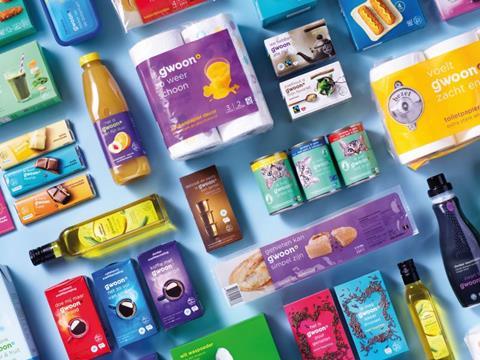
How can a private label be created that differentiates itself through design, and create shelf standout when category values are defined by others? Robert Kuiper, partner and managing director of Brandnew brand designers, talks about ways to achieve successful private label designs, and trends and developments in the industry.
Brandnew was asked to help create a private label that is adaptive to each retail formula and category but bound by specific brand values. We had to let go of grids, as the product category was never our starting point. We wanted a design strong enough to communicate brand values, uniting the wide range of products that defined the brandname G'woon. All products have a premium look & feel and are eye-catching thanks to their colourful packaging and funny tag lines matching the brand's character - not overpromising but real.
The brand name is featured in every tag line, such as 'simply super soft' for toilet paper. Or 'simply super fresh' for fresh vegetables, and ‘simply with extra vitamine C’ for orange juice.
Private label as brand weapons
Private labels have been booming due to recent financial crisis, powered by design. Consumers wanted a cheaper version of premium brands, and private labels thrived. However, the past few years premium brands have been on the offensive. Premium labels, however, are fighting their way back. If private labels want to keep their newly owned high ranked position, then it’s time for them to take the next step. Private labels need to evolve into true brand weapons; they need to become private brands. And in this evolution, brand design is the driving force.
Through packaging design, private labels have been differentiating themselves from premium brands by not just being a cheap copy, but having an identity of their own. When this identity is based on your own brand values instead of the design and values of another brand, you can turn a private label into a private brand - one that appeals to consumers in the same way a premium brand does.
Moving to premium
Private labels are moving away from the budget segment and moving into the more premium sphere, product and design wise. This is partly reactive, driven by advances driven by brand owners, but also because retailers are seeing the advantages of growing their private labels into private brands. Private brands were once known as ‘low pricing, less quality’ options. But over the past years private brands have been consistent in their good pricing, and moved towards a more competitive level towards premium brands when it comes to quality. Consumers seem to have changed their buying as well; private brands turned from their cheap to their favourite picks. This is where evolution takes place: Private labels transform from surrogate into private brands that can easily replace premium brands.
Keeping it sustainable
The key driver at this moment is packaging waste reduction. The social responsibility retailers have to reduce their impact on waste and to meet their sustainability goals they have to drive new technology. Examples are recyclable materials, skipping unnecessary packaging materials (e.g. double or triple packed). This goes as far as retailers that sell food without any packing at all like OU (Original Unverpackt) and the packaging free Ekoplaza store in NL.
The second key driver is food waste reduction. This aim which has probably even bigger impact on the planet, is found back in creating smaller packs/portions but also in new developed packs that keep food fresh longer. So it’s either buying less/exactly what you need and/or keeping the bought food fresh. The third key driver is not as noble but more commercial: creating packs that simply stand out. This is currently mostly seen on shelf by category crossing pack use. So for example cans for non-liquids, bags for liquids, pizza in foil etc.
Ecommerce
The emergence of e-commerce is one of the reasons premium brands have been able to reclaim territory they lost to private labels during and after the financial crisis. While retailers were focused on classic ways of store branding and marketing, brands have been investing in innovation, communication and e-commerce – with success.
Future developments
Retailers will embrace the concept of a private brand. The power of this lies in the connection between the retail formula, the assortment and the private brand. This connection enables them to position and distinct themselves from other retailers. E.g retailers will perform as brands rather than the resellers. The result is a much more interesting and diverse landscape of retail brands, products and packs. Not proximity or price as a key driver to shop, but a true engagement to the brand. Next to this belief we see e-commerce breaking through fast. Most likely it will be successful especially in the non-distinctive assortments (commodities, interchangeable products). This means that the supermarkets will have to have a much smaller focus on this assortment in the physical store which creates more room for the distinctive assortment. The share of private label can grow, especially in the more brand-building-assortments.

















